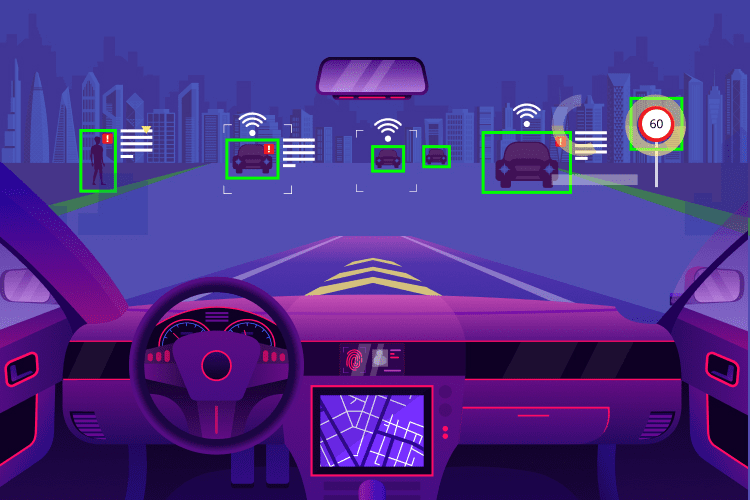
DeepLobeFebruary 8, 2021Artificial Intelligence , Computer Vision
The autonomous vehicles segment has recently seen a tremendous growth, all thanks to computer vision. Classifying and detecting objects, signs, humans, other vehicles on the path, marking 3D maps, real-time traffic insights, etc., are a few research advancements in the field of computer vision. And these advancements are driving the growth of computer vision in developing next-gen vehicles at a scale. Automobile manufacturers across the globe are pouring in huge investments to build smart and reliable autonomous vehicles driven by the vision of AI. With any heavily developing field, it becomes difficult to stay up-to-date at a pace with time. In this article, we described how computer vision technology is leveraging state-of-art strategies and making autonomous vehicles more reliable.
Computer Vision in Automotive Industry – Unexploited
Computer vision could make a real difference in the automotive industry by adding safety features to our vehicles. Object detection and predictive decision-making are empowering machines to save countless lives and property every day. The application of computer vision in the automotive industry is aged back to the 1960s. In 1966, computer vision was pioneered by universities that are researching artificial intelligence to build scalable solutions. The computer vision systems built at that time are meant to mimic the human visual systems. And researchers distinguished computer vision systems from the prevalent field of digital image processing at that time as a desire to extract 3D structure from images to achieve full scene understanding.
Studies in the 1970s formed the early foundations for many computer vision algorithms that we use today – like digital image processing, 3D structurization, motion estimation, non-polyhedral and polyhedral modeling, and more. With time, the advancements in computer vision technology achieved the objective of full scene understanding and helped in better decision making. In the next decade, studies based on rigorous mathematical analytics and quantitative aspects of computer vision helped engineers in building more reliable tools for future technological advancements. Today the applications of computer vision are earning vital space. In some fields of AI, which deal with autonomous path planning or deliberation for robotic systems to navigate through an environment, computer vision has become an irreplaceable practice.
Artificial intelligence and computer vision share the most common applications in building the future of autonomous vehicles. Pattern recognition and learning techniques to solve puzzled patterns are some of the most common practices. Infusing computer vision algorithms is helping automotive manufacturers in planning and building state-of-art strategies to manufacture the 5 levels of autonomous vehicles. We can soon expect to see vehicles that can coordinate with other vehicles connected through IoT in their environment to avoid collisions and reduce the traffic flow time through adopting a technique called swarm intelligence, which is commonly observed in ants for locomotion. It is expected that the growth of computer vision technology will compound annually at a growth rate (CAGR) of 7.6% from 2020 to 2027.
Computer Vision & Autonomous Vehicles – Current Applications
The manufacturing of autonomous vehicles revolutionized the vehicle production industry in the 21st century. Incorporating intelligence in automotive manufacturing is driving innovation. Advancements in computer vision software are making the ideas of the SciFi world more realistic than ever before. Here we describe a few applications of computer vision that are helping in building more safer and reliable autonomous vehicles.
1. Classifying and detecting objects
Computer vision or machine vision is an emerging toolkit that aims to provide the utmost accuracy in identifying objects or classifying them within a fraction of a second. Object detection to image classification is a series of techniques performed within digital image processing to provide expert-level solutions for effective decision making.
How does it work?
An image recognition sensor captures a representation of the image, then a processing core analyzes it by comparing it to existing input with an existing collection of databases. Once the system identifies its match, it decides by performing a trial and error method until it concludes.
2. Path planning and lane changing
In today’s era, self-driving vehicles are more than a trend. The advanced computer vision employed in automotive applications uses a combination of distinct techniques to assist the driver by identifying simple objects such as road lanes, traffic signs, and road boundaries. These techniques will help in effective path planning and road lane-changing decisions. Self-driving cars can be good examples for explaining how this technology works and why a self-driving vehicle can make simultaneous decisions to avoid a crash.
3. Ensuring 3D maps
3D mapping and wireframing the collected visual information in real-time helps autonomous vehicles in making data-driven decisions. The cameras attached with vehicles help in recording live footage and allow computer vision to create 3D maps. This helps a self-driving vehicle to better understand its surrounding environment, objects, and signals. And further, applying object detection, obstacle avoidance, and opt for alternative or best routes for reaching the desired destination.
3D maps ensure that self-driving vehicles are more safe and reliable. Hence, computer vision can help automotive manufacturers in constructing self-driving vehicles that can avoid obstacles, prevent accidents, and protect passengers in the event of a crash.
4. Weather independent
Being weather independent makes computer vision technology one of the most reliable and successful applications in building the future of autonomous vehicles. Computer vision applied IoT sensors can be operated by measuring light variations to determine distance and angles for making reliable weather decisions. Some weather conditions could cause a problem, yet computer-vision-enabled low-light-mode processes low light images and videos for analyzing data that could be accurate enough for driving unpredictable climate conditions.
As soon as computer vision detects a low-light condition, the system uses an AI-powered different set of algorithms to obtain data using LiDar sensors, thermal cameras, and HDR sensors.
5. Signal processing
Signal processing and decision-making make autonomous vehicles intelligent and reliable. Traffic signal identification, pedestrian detection, and lane detection are vital practices of the signal processing system. For instance, a machine vision system is trained with thousands of traffic signals that enable the software to make data-driven decisions in real-time.
Self-driving vehicles can be made intelligent, self-reliant, and reliable by using computer vision technology. However, the vehicles may face distinctive challenges throughout the development process. Current driving environments are built for human use and driving semi-autonomous or fully leveraged autonomous vehicles in this environment can be problematic. Adopting computer vision readable signs and marking the current road environments to make them more machine-readable is time-consuming and costly. So the computer vision in autonomous vehicles is driving growth, and the development of this technology is happening at a fast pace.
